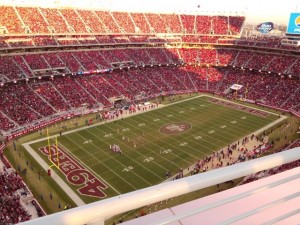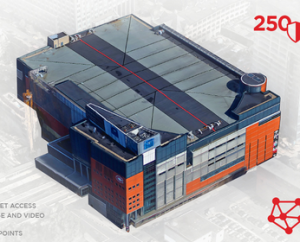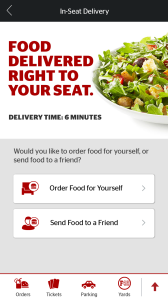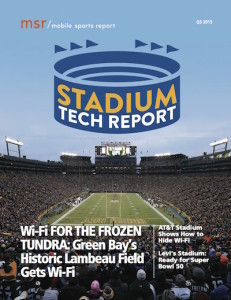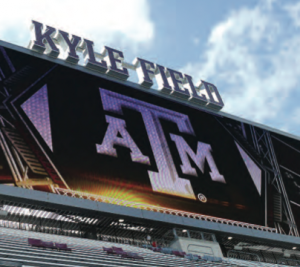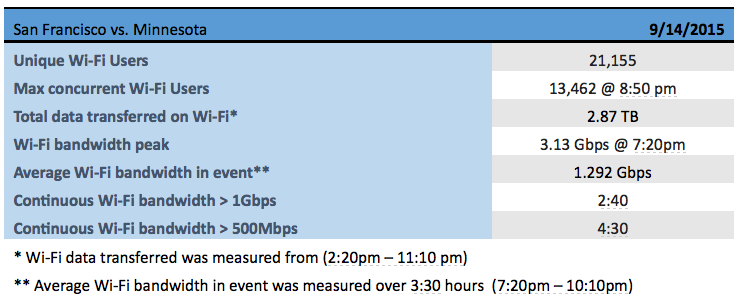But before looking ahead to the big game, it’s a worthwhile time to take a look back at the first year of one of the most anticipated new sports venues, to assess what worked, what didn’t, and what the Niners are doing to make Levi’s Stadium even better in its second year on earth.
In an exclusive interview with Niners COO Al Guido, Mobile Sports Report found that overall the team is extremely pleased with both the stadium’s wireless networks and its ground-breaking stadium mobile app, which supported innovative services like in-seat delivery of food and beverage to every seat in the house, as well as electronic ticket access and instant replays of action on the field.
(Editor’s note: This story is an excerpt from our most recent Stadium Tech Report, the PRO FOOTBALL ISSUE, which is available for FREE DOWNLOAD right now from our site. In the report our editorial coverage includes a profile of the new Wi-Fi network at Green Bay’s Lambeau Field, a profile of Wi-Fi concealment techniques at AT&T Stadium, and team-by-team profiles of Wi-Fi and DAS deployments at all 31 NFL stadiums. Get your copy today!)
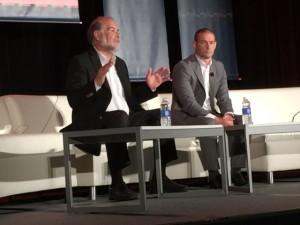
VenueNext CEO John Paul, left, and Niners COO Al Guido discuss Levi’s Stadium at a ticketing conference this past spring.
Wi-Fi and DAS: Great, and getting better
Prior to the official opening of Levi’s Stadium, executives from the Niners were blunt and brash in their public statements about how awesome they expected the stadium’s Wi-Fi network to be. But as anyone who’s launched a large public venue network knows, the proof only comes after you fill the house with users who test the system in ways nobody can ever really imagine.
“Lots of people were skeptical about some of the things we had planned, like food ordering to every seat,” Guido said. “We knew the app would perform fine, but a lot of [what was planned] was based on whether the network could pull off the bandwidth needed. The biggest question [before opening] was what the network would look like.”
Given the high expectations, it would be easy to fall flat, but the Levi’s Stadium Wi-Fi network – with Brocade equipment at its core, Aruba Networks gear for the Wi-Fi infrastructure and Com- cast Xfinity services for bandwidth – was solid from the get-go, recording 3.3 terabytes of data for its regular-season opener, a mark that surpassed the Wi-Fi total from the previous Super Bowl.Though it wasn’t perfect – the network team originally hadn’t provided enough bandwidth for older devices that only supported Wi-Fi communications at the 2.4 GHz frequency – the Wi-Fi network started strong and remained that way throughout the year. Designed and deployed by former vice president of technology Dan Williams – and overseen by Chuck Lukaszewski, very high density architect in the CTO Office of Aruba Networks – the Wi-Fi network allowed the Levi’s Stadium app to shine, particularly in the high-bandwidth areas of Internet application access, in-stadium video replays, and the all-important food and beverage ordering.
Over the course of the football season and a bunch of other events that followed, including concerts, the WrestleMania 31 event and an outdoor hockey game, the Levi’s Stadium Wi-Fi network recorded around 415,000 unique users, who consumed more than 45 TB of data, according to the team.
“Dan and his team did a hell of a job” on the network, Guido said. “We felt very good about the performance of the network – we’re able to do things with data and video that no other teams could do.”
On the DAS side, deployment partner DAS Group Professionals said that the cellular network inside the stadium also performed as designed, hitting goals for near-perfect availability the first game out and not dipping below that mark during subsequent events. Because of higher than expected traffic increases for the upcoming Super Bowl, the carriers using the DAS asked for (and paid for) a complete overhaul of the DAS system, which is expected to be completed during the first part of the 2015 NFL season.
On-field APs and more APs for concourses
One twist to the Wi-Fi network added during the course of the first 12 months is the deployment of a temporary on-field Wi-Fi network for concerts and other events that have seating on the stadium floor, where the football turf is.
“We didn’t think about the field at first because there’s not a lot of tech allowed on the field by the NFL,” said Guido, referring to the league’s exclusive control of on-field wireless technology on game days. By placing APs under the temporary field flooring and adding others to temporary-seat railings, the network team was able to deliver connectivity to the premium seating there, a key hurdle that will allow Levi’s Stadium to continue to attract marquee events that demand such features.
The temporary-network lessons learned during concerts will also be applied during the Super Bowl, when the stadium will add a couple thousand temporary seats in the large open concourse areas in the stadium’s corners. Other small tweaks to the Wi-Fi network include more APs installed this offseason in and around the corner concourse concession stands, structures that were added to the design after the stadium opened; and more overhead APs in the standing-room-only areas of the lower concourses above each sideline, where lots of human bodies last year blocked signals coming from APs pointing up from the last row of seats.
According to Aruba’s Lukaszewski, the Wi-Fi network at Levi’s Stadium “did what it was supposed to do” last season, carrying high loads of wireless traffic. One stat the Levi’s team invented for its own network was “amount of time the network spent carrying more than 1 Gbps” – a total that Lukaszewski said reached 21 hours and 30 minutes across the 10 NFL events, and 31 hours 40 minutes across all 20 events.
Unlike other stadiums, which have needed massive Wi-Fi upgrades before hosting the Super Bowl, Levi’s Stadium appears to be ready for game day right now, at least when it comes to Wi-Fi.
(See part 2 of this excerpt tomorrow)

